4- Action Potentials + Conductance
1/27
There's no tags or description
Looks like no tags are added yet.
Name | Mastery | Learn | Test | Matching | Spaced |
|---|
No study sessions yet.
28 Terms
2 types of channels found in a neuron
“leak” channels: always open for K and Na in the resting cell, responsible for the resting potential
gated channels: can exist as open or closed
2 types of gated channels
voltage-gated: open or close when the membrane charge (voltage) changes
ligand-gated: open when a ligand (chemical substance) binds to the channel
what happens when a resting neuron is stimulated
generation of action potential:
creates a disruption in the membrane → opening of voltage-gated channels for Na+ → membrane potential to move towards ENa
any change that moves the membrane potential closer to 0 is called
depolarization
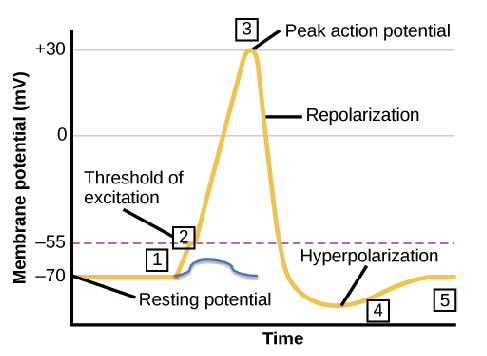
describe what’s happening at 3
incoming Na+ establishes positive charge on interior of membrane called the overshoot, which peaks at between +30 and +50 mV
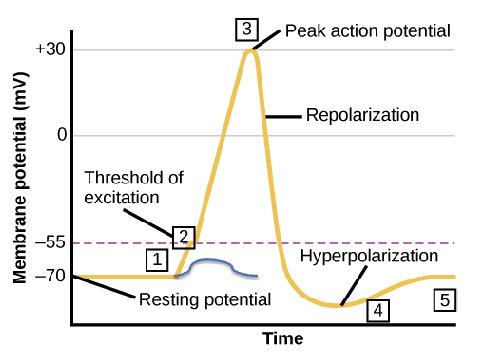
describe what’s happening at the repolarization
Na+ voltage-gated channels close and K+ voltage-gated channels open → outward flux of K+ → membrane repolarized to original resting potential
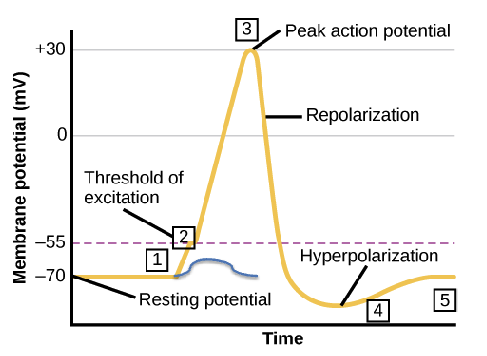
describe what’s happening at hyperpolarization (4)
b/c not all of the K+ voltage gated channels close in time, the potential becomes more negative than the normal resting potential (hyperpolarized)
graph of action potential shape is determined by what
different voltage-dependent and time-dependent gating properties of Na+ and K+ channels
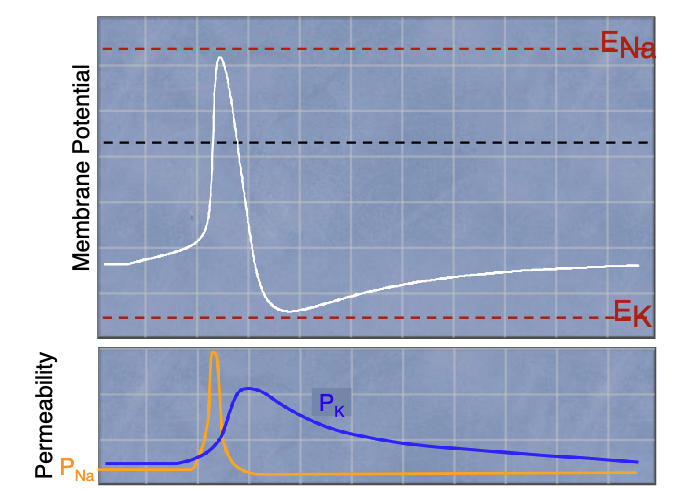
T/F: Na+ and K+ channels do not open at the same time
true, Na+ opens first
in an action potential, Na+ and K+ channels flow in or out
Na+ channels: in
K+ channels: out
what’s the all or none principle
once threshold is reached, an action potential reaches full amplitude
what’s the absolute refractory period
the time during which it is impossible to generate a second action potential
why does the absolute refractory period exist
due to sodium channel inactivation:
sodium channels close to an inactivated state that takes 2-3 msec to relax to a true closed state
the closed state can be reopened by a stimulus but the inactivated state cannot
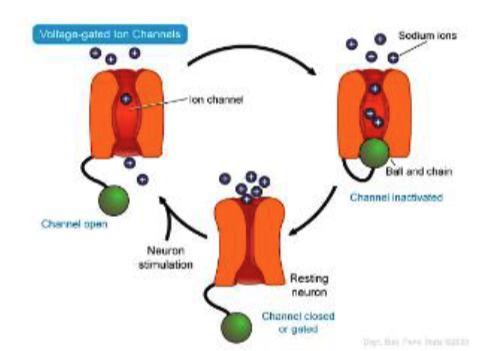
how does local anesthetic use sodium channel inactivation
local anesthetics are hydrophobic amines (ex: lidocaine) that act at a defined site on Na+ channels and lock the channel in its inactive conformation
what’s the relative refractory period
the time during which a second action potential can be generated but would require a stronger stimulus to reach threshold
describe the mechanism of relative refractory period
the larger stimulus is necessary to open enough Na+ channels to override the efflux of K+ whose permeability is still above the resting state
however, action potential will have a reduced amplitude b/c the influx of Na+ is partially counteracted by the K+ efflux
the amplitude will return to normal when voltage gated K+ channels have completely closed
how does an action potential move along an axon
via conduction

describe how describe conduction occurs in this axon pictured
influx of Na+ → Na+ will diffuse laterally along the inside of the membrane to the right → neutralizes the inside negative charge in adjacent axon segment and raises potential to threshold → initiating an action potential in this segment, while outward flux of K+ is repolarizing previous segment
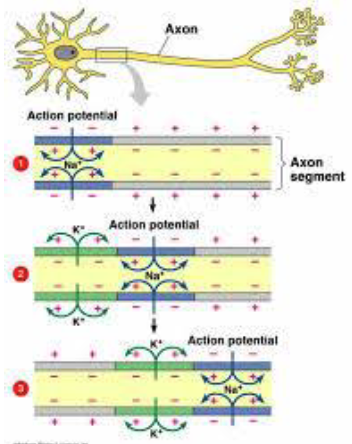
the spread of an action potential as it moves down the axon in segments is called
regenerative current, aka a new action potential generated in each axon segment
T/F: conduction is unidirectional
true, demonstrating the refractory period
where can the Na+ and K+ current can only flow through the membrane in myelinated neurons
at the nodes of Ranvier, b/c the myelin sheaths act as insulators
since Na+ and K+ current can only flow at nodes of Ranvier, the action potential has to
“jump” from node to node, aka the saltatory conduction → thus conduction is faster within myelinated neurons
describe the conduction in a leaky membrane
a leaky (to ions) membrane loses current as the potential spreads passively down the fiber
the leakier the cell, the spread of the potential becomes limited

what is the length constant γ
quantifies the distance that a graded electrical potential can travel passively down an axon before it decays to ~ 37% of its original amplitude


what does rm and ri mean
rm = resistance to ion current through the membrane
ri = resistance to ion flow in the axoplasm; viz axial resistance
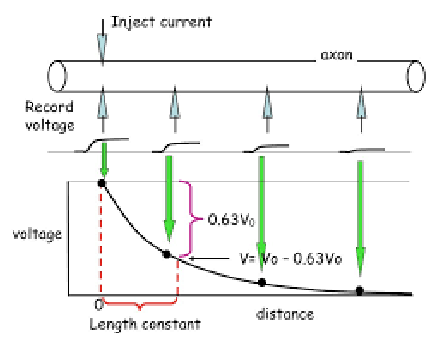
what does high length constant (γ) mean
low ri and/or high rm, the axon will depolarize to threshold further down from where the injection occurs → increase in conduction velocity
what increases length constant (γ)
myelination → increases rm
larger axon diameter → decreases ri
describe mechanism of demyelinating diseases (ex: multiple sclerosis)
removal of myelin sheath exposes the underlying membrane which lacks vg-Na+ channels, but has many vg-K+ channels
inward Na+ current at the nodes is dissipated in the demyelinated region by the outward K+ current, preventing the depolarization from reaching the Na+ channels in next node → conduction failure